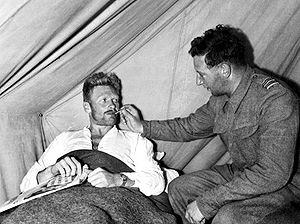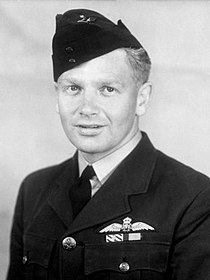Nicky Barr
Nicky Barr | |
|---|---|
Wing Commander | |
| Unit | No. 23 Squadron (1940–1941) No. 3 Squadron (1941–1942) No. 2 Operational Training Unit (1944–1945) |
| Battles/wars | World War II
|
| Awards | |
| Other work | Company director |
Andrew William "Nicky" Barr,
Barr's achievements as a combat pilot earned him the
Early career
Andrew Barr was born in
Returning to Australia on the
Combat service

Barr was posted to
Eventually credited with victories over twelve enemy aircraft, plus two probables and eight damaged, Barr became No. 3 Squadron's highest-scoring member.[8][13][14] He flew a total of eighty-four combat sorties, twenty of them in one fortnight, and six on 16 June 1942 alone.[14][15] His philosophy was that the P-40 was not a top-class fighter, but that its shortcomings "could be offset by unbridled aggression", so he resolved to treat aerial combat as he would a boxing match and "overcome much better opponents by simply going for them".[11] Bobby Gibbes became No. 3 Squadron's commanding officer in February 1942, and made Barr his senior flight commander.[16] Promoted to flight lieutenant on 1 April, Barr was raised to acting squadron leader and appointed to command the unit in May, barely six months after he commenced operations, following Gibbes's hospitalisation with a broken ankle.[4][17] Barr had never sought leadership of the squadron, and felt that others were just as well qualified for the role.[18] As a commander he delegated most administrative tasks to his adjutant but, contrary to normal practice, wrote letters to the next-of-kin of casualties himself.[5]
... it had two guns firing from the cockpit and four – two in each wing – to augment it. And I liked very much indeed the loading of the guns when one took off. There was a closeness to combat which seemed to help me with my make-up, the smell of cordite in the cockpit was particularly helpful to me; I really felt that I was at a war.
— Nicky Barr on the P-40 Tomahawk, interview, 1990[5]
Barr was shot down three times while serving with No. 3 Squadron. The first occasion was on 11 January 1942 when, having destroyed a Bf 109 and a

This officer, who commenced operational flying in November, 1941, has displayed the greatest keenness and skill as a fighter pilot. In December, 1941, during a patrol over the Derna area, he shot down a Messerschmitt 110; the next day, in the same area, he destroyed a Messerschmitt 110 and a Junkers 88. One day in January, 1942, his squadron formed part of an escort to bomber aircraft operating over El Agheila. Enemy aircraft were encountered and, in the ensuing engagement, Flying Officer Barr attacked 2 Italian fighters, one of which he shot down. He then observed one of his fellow pilots, who had been shot down, waving to him from the ground but, when preparing to make a landing in an attempt to rescue him, Flying Officer Barr was attacked by 2 Messerschmitt 109s. Although the undercarriage of his aircraft was not fully retracted, he immediately manoeuvred to engage the attackers, only to find that his guns had jammed. Quickly rectifying the fault he delivered an accurate burst of fire which caused one of the Messerschmitts to disintegrate in the air. A further 2 enemy aircraft joined in the combat and Flying Officer Barr was wounded and forced down. While on the ground he was further wounded by the enemy's fire but, despite this, he made his way through the enemy's lines and rejoined our own forces some 3 days later. He brought back much valuable information regarding the disposition of enemy tanks and defences. Flying Officer Barr displayed the greatest courage and tenacity throughout. He has destroyed 8 enemy aircraft.
On 25 May 1942, Barr had to land in the desert when his engine overheated. Having just taken off the engine cowling, he spotted enemy tanks approaching and immediately took off with the engine exposed to the elements, safely landing back at base.[8][13] He was shot down for the second time on 30 May,[13] when he engaged eight Bf 109s and destroyed one before being hit and forced to crash land at high speed in no-man's land. He came down in a minefield during a fierce tank battle, and was forced to remain where he was as troops of both sides slowly converged on him; British forces managed to reach him first and, after treatment for wounds, he again returned to his squadron.[8][24] On 26 June, after being attacked by two Bf 109s and bailing out of his burning Kittyhawk, he was captured by Italian soldiers and taken as a prisoner-of-war, first to Tobruk, and then to Italy, where he received hospital treatment for serious wounds.[13][25] He later learned that the pilot who shot him down was Oberleutnant Werner Schroer, a Luftwaffe ace credited with sixty-one victories in North Africa.[26] Bobby Gibbes, having recovered from his own injuries, again took command of No. 3 Squadron.[27] During his incarceration, on 5 February 1943, Barr was awarded a Bar to his DFC for "destroying further enemy aircraft".[28][29]

Barr tried to escape from his confinement four times.[30] By November 1942 he had recovered sufficiently from the injuries he received in June to break out of the hospital where he was being held in Bergamo, northern Italy.[31] He made his way to the Swiss border, but was challenged by an Italian customs official, whom he struck with a rock before being recaptured. Court-martialled on a charge of murder, he only avoided a death sentence when the Swiss Red Cross colonel representing him located the official and proved that he had not died. Barr was instead sentenced to ninety days solitary confinement in Gavi Prison Camp, Genoa.[32] In August 1943, with Italy on the verge of surrender, prisoners of war were rounded up for transport to Germany.[33] Barr jumped from a moving train bound for the Brenner Pass and joined a group of Italian partisans in Pontremoli, remaining at large for two months before again being captured. Taken to a transit camp just over the Austrian border, Barr and fourteen other prisoners escaped by tunnelling under the barbed wire.[34] Eventually he managed to link up with an Allied special operations unit, which was gathering intelligence behind enemy lines, sabotaging Axis infrastructure, and helping Allied prisoners and Italian refugees escape over the Apennine Mountains along the so-called "Alpine Route".[35] He was recaptured and escaped once more before finally making it through the Alpine crossing himself, leading a group of more than twenty. After reaching friendly lines in March 1944, he was sent to a military hospital in Vasto, weighing only 55 kilograms (121 lb) and in poor health, suffering malaria, malnutrition, and blood poisoning.[8][36] The assistance he rendered to fellow Allied fugitives earned him the Military Cross (MC) for "Exceptional courage in organising escapes"; the award was gazetted on 1 December 1944.[37][38] He is thought to be one of only five or six RAAF pilots to receive the MC during World War II.[8]
Posted to Britain in April 1944, Barr went ashore at
Later career
I was not very proud of the things that I was called upon to do. Nonetheless, I accepted the fact that some people have to do the killing. But when you are recruited, it's not sold to you that way and you find out that after they teach you to fly they then teach you to kill. And, uh, I didn't like it at all, but I did it – that was my job.
— Nicky Barr, Australian Story, 2002[30]
After leaving the Air Force, Barr remained in Mildura with his wife, Dorothy (Dot). They had met on a blind date in 1938 and been married only a few weeks when Nicky joined the RAAF. During the war she was told on three occasions that her husband was dead.
In 1961, Barr became General Manager of Meggitt Ltd, an
Notes
- ^ a b c "Item 023231". Australian War Memorial. Archived from the original on 5 September 2012. Retrieved 26 November 2015.
- ^ Dornan 2005, pp. 5–8
- ^ Dornan 2005, pp. 9–10
- ^ a b c d e f g "Wing Commander Andrew William Barr, MC, DFC & bar". Australian War Memorial. Retrieved 26 November 2015.
- ^ a b c d e Barr; Stokes 1990
- ^ a b Dornan 2005, pp. 10–12
- ^ Dornan 2005, pp. 15–17
- ^ a b c d e f g h i j Garrisson 1999, pp. 113–115
- ^ Dornan 2005, p. 22
- ^ Dornan 2005, pp. 23–25
- ^ a b Thomas 2005, pp. 22–23
- ^ Herington 1954, pp. 223–224
- ^ a b c d Newton 1996, pp. 65–66
- ^ a b c d e "Goodbye to Aussie great". Air Force News. 29 June 2006. Archived from the original on 4 March 2016. Retrieved 26 November 2015.
- ^ Herington 1954, p. 241
- ^ Dornan 2005, pp. 80–81
- ^ Thomas 2005, p. 33
- ^ Dornan 2005, pp. 94–95
- ^ Wilson 2005, pp. 86–87
- ^ Delve 2017, p. 159.
- ^ Dornan 2005, pp. 67–73
- ^ "No. 35463". The London Gazette. 20 February 1942. p. 844.
- ^ "Recommendation: Distinguished Flying Cross" (PDF). Australian War Memorial. Retrieved 26 November 2015.
- ^ Dornan 2005, pp. 106–107
- ^ Thomas 2005, p. 38
- ^ Dornan 2005, pp. 137–138
- ^ Herington 1954, p. 244
- ^ "No. 35891". The London Gazette (Supplement). 2 February 1943. p. 653.
- ^ "Recommendation: Bar to the Distinguished Flying Cross" (PDF). Australian War Memorial. Retrieved 26 November 2015.
- ^ a b c "The Quiet Man". Australian Story. ABC Television. 1 April 2002. Retrieved 26 November 2015.
- ^ Dornan 2005, pp. 153–155, 158–161
- ^ Dornan 2005, pp. 163–171
- ^ Dornan 2005, p. 190
- ^ Dornan 2005, pp. 196–204
- ^ Dornan 2005, pp. 210–211
- ^ Dornan 2005, pp. 222–224, 231–239
- ^ "No. 36820". The London Gazette (Supplement). 28 November 1944. p. 5515.
- ^ "Recommendation: Military Cross" (PDF). Australian War Memorial. Retrieved 26 November 2015.
- ^ Dornan 2005, pp. 247, 253–257
- ^ Dornan 2005, pp. 263–264
- ^ Dornan 2005, pp. 267–268
- ^ Dornan 2005, p. 7
- ^ "Reluctant Hero". The Age. 25 April 2002. p. 1 (Culture section). Retrieved 26 November 2015.
- ^ a b c d Dornan 2005, pp. 273–274
- ^ Dornan 2005, pp. 275–276
- ^ "No. 49213". The London Gazette (Supplement). 30 December 1982. p. 42.
- ^ Dornan 2005, pp. 276–277
- ^ "Andrew "Nicky" Barr and the 1939 Wallabies tour". The Age. 17 June 2006. Retrieved 26 November 2015.
- ^ "Memorial honours a squadron hero". Air Force News. 5 October 2006. Archived from the original on 4 March 2016. Retrieved 26 November 2015.
References
- Barr, Nicky; Stokes, Edward (3 July 1990). Transcript of oral history recording: Barr, Andrew William 'Nicky' (Squadron Leader) (PDF). The Keith Murdoch Sound Archive of Australia in the War of 1939–45. Canberra: Australian War Memorial.
- Dornan, Peter (2005) [2002]. Nicky Barr: An Australian Air Ace. Crows Nest, New South Wales: ISBN 1-74114-529-5.
- Delve, Ken (2017). The Desert Air Force in World War II: Air Power in the Western Desert, 1940–1942. Barnsley: ISBN 978-1-844-15-817-1.
- Garrisson, A.D. (1999). Australian Fighter Aces 1914–1953. Fairbairn, Australian Capital Territory: Air Power Studies Centre. ISBN 0-642-26540-2. Archived from the originalon 24 November 2016.
- Herington, John (1954). Australia in the War of 1939–1945: Series Three (Air) Volume III – Air War Against Germany and Italy 1939–1943. Canberra: Australian War Memorial. OCLC 3633363.
- Newton, Dennis (1996). Australian Air Aces. Fyshwyck, Australian Capital Territory: Aerospace Publications. ISBN 1-875671-25-0.
- Thomas, Andrew (2005). Tomahawk and Kittyhawk Aces of the RAF and Commonwealth. Oxford: ISBN 978-1-84176-083-4.
- Wilson, David (2005). The Brotherhood of Airmen. Crows Nest, New South Wales: Allen & Unwin. ISBN 1-74114-333-0.
